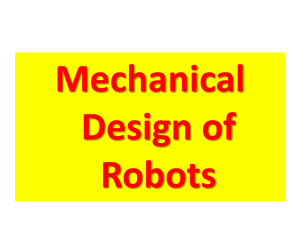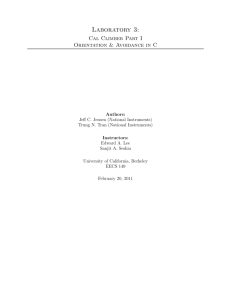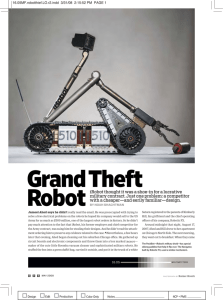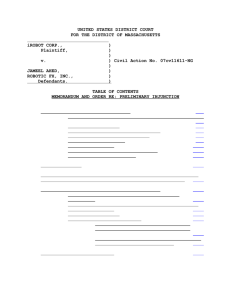iRobot, Prosthetic Arm, and Rescue Robot
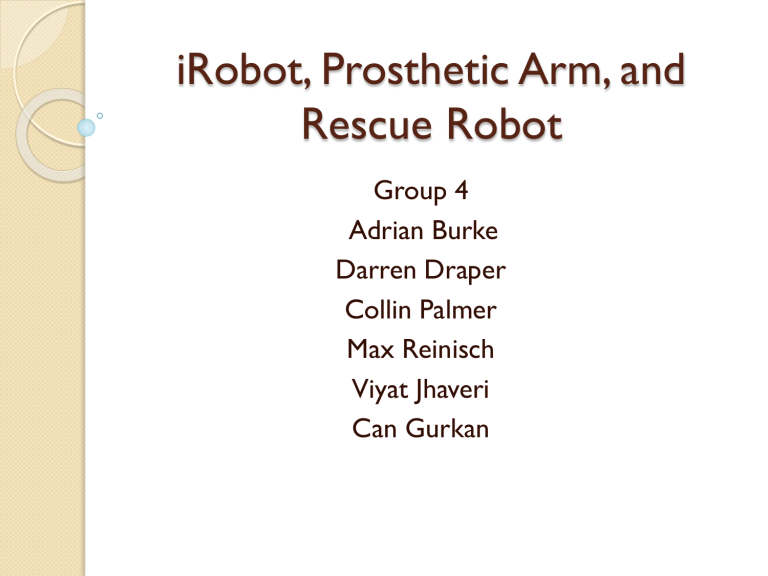
iRobot, Prosthetic Arm, and
Rescue Robot
Group 4
Adrian Burke
Darren Draper
Collin Palmer
Max Reinisch
Viyat Jhaveri
Can Gurkan
The Plan
iRobot-
◦ We first had to understand the basic programming skills so that we could be able to understand the code that was given to us.
◦ Naranjan versed us on the basics of the iRobot and we got a better idea of basic programming and functions
◦ We had to be able to write a section in the programming so that the robot could meet the specifications for the required task.
The Plan cont.
Rescue Robot-
◦ We first had to figure out a design that would fit the environment that it would have to search.
◦ After, we had to program the robot so that it could make it through the course by following a black line of tape and be able to avoid obstacles and return to the tape.
◦ We used a basic three-wheeled design that was capable of handling the decline on the rugged stairs and maneuver on the black line
The Plan cont.
Prosthetic Arm-
We started with a flow chart to design the functions of each motor on the robot
After, we created a large base and truss design at a 90 degree angle to start the arm
We only used motors because a pulley system was less reliable, and the sensors weren’t functioning when we tested them
The Process
iRobot-
The process for creating the iRobot was working closely with Niranjan to understand the code, fix code to correct small miscalculations, and then constantly test and re-test the iRobot to make sure it met all of the specifications
This process was a very important process when reading and re-writing code to correct very small errors
The Process cont.
Rescue Robot-
We used a basic three-wheeled design to scale the stairs and a large base on the robot to maintain stability
With the large amount of experience with Lego
Mindstorms, this robot didn’t require much planning or design
The most labor-intensive part of this robot was programming it to make turns and follow the black line
We used a touch sensor to detect obstacles and a distance sensor on the back to make sure people can follow the robot
The Process cont.
Prosthetic Arm:
We created the basic truss and base design and then added the cross bars for the moving gears on the shoulder joint
Once finished, we added the elbow and forearm with another motor with extra support
We constructed the hand separately and only used one motor on the two fingers to grasp the cup
We finally connected the two pieces and began testing, remodeling, and programming the prosthetic arm
Principles Used
For the prosthetic arm, we used basic principles of weight distribution and simple machines to create a strong system
The principles we learned from levers was helpful when adding the counterweight after we tested the arm
We decided not to use a pulley-system in order to keep the design simple and maintain structural integrity
Principles cont.
For the iRobot, we used many principles from computer engineering. With the help of Niranjan, we learned how to use programming language and apply code to the robot
We found that the most important principle was patience
◦ We constantly had to recalibrate the robot and change code according to the testing we did
Principles Cont.
In the rescue Robot, we used the basic principles of stability and weight distribution when constructing the robot
We also applied the basic programming principles and flow charts when designing the programs
Everyone’s Jobs
We split the three robots between the six group members.
Darren- Head designer and builder for prosthetic arm, help with powerpoint
Collin- Builder and head programmer for prosthetic arm
Adrian- Programmer for iRobot
Viyat- Builder and head programmer for rescue robot.
Can- Head builder for rescue robot.
Max- Documents and assistance for iRobot and search robot.
Niranjan- Head programmer for iRobot
Successes and Challenges
In the iRobot, starting the program was challenging and very difficult to comprehend.
◦ Eventually, with Niranjan’s help, we were successful in creating and understanding a successful program.
In the search Robot, building was fast and simple. Unfortunately, creating a successful program was challenging and required the collaboration of other groups, but eventually worked.
Successes and Challenges cont.
The prosthetic arm had many challenges.
◦ We had a solid design, but created a few limitations on motion when we connected the joints
◦ After making many minor, but very important changes to the design, we were able to create a strong system by moving and removing parts to create more space
◦ Furthermore, the programming was challenging and took a lot of time when applying the new programs
Obstacles and how
We Overcame Them
For the rescue robot, there were fewer major problems in our design and creation
◦ We had trouble turning right and getting the robot to stay on course so we constantly rewrote the programs until we found one that worked
◦ We also needed to make a wheel and base design that was big enough to overcome the problem with scaling the stairs and creating traction
Obstacles and how
We Overcame Them cont.
For the iRobot, our biggest problem was understanding the code
◦ Niranjan helped us understand and apply the code to the robot to perform all of the specified functions
◦ After we overcame the basic problem of coding, we made minor changes to perfect its functionality
Obstacles and how
We Overcame Them cont.
For the Prosthetic arm, the biggest obstacle was the programming process.
◦ We anticipated an easier programming process after spending a lot of time on designing and creating a strong system
◦ The brains and sensors didn’t always function or perform as we had planned and we had to change our design because of that
◦ We also needed to add a large amount of counterweight because of our heavy hand and we had to relocate the cross bars to increase motion
How We Would Improve
If we had more time to build the rescue robot, we would have spent more time on the initial design process.
◦ We would use a flow chart and carefully plan out each task the robot would have to overcome before we start programming
◦ It would have also been helpful to have the search robot course in the same room as the computer, eliminating time spent walking between rooms.
How We Would Improve cont.
We would like to study and understand how to robots functions and programming for some time before we begin programming the robot
◦ This would make the programming process faster and more successful
We would have improved the iRobot by making a program to completely retrace its steps once it found a person.
◦ Although this would require at least an extra day to program, it would create a better and more applicable robot to the designated tasks
How We Would Improve cont.
We would have improved the prosthetic arm by making a lighter hand so we could use fewer counterweights.
We would also redesign the basic structure of the elbow to give the robot more flexibility and capability
If we had time, we would try to limit our motors and parts to the bare minimum to create a cost-efficient and strong system
Lessons Learned
We all learned how the distribution of a work can expedite the entire process
We also learned that we should never anticipate any process to be easy and expect there to be bugs in all processes.
Furthermore, although we are competing with the other groups to create the best product, we found that intra-team collaboration came in handy
If We Had to Repeat the Project
If we were to re-do the project, we would make sure that all of our modules work at their best
We would also try to spend more time learning about programming all of the robots as a team so we could help each other program after construction and expedite the process
We would maintain our design process and attack for the project because our group work and distribution of tasks was successful



